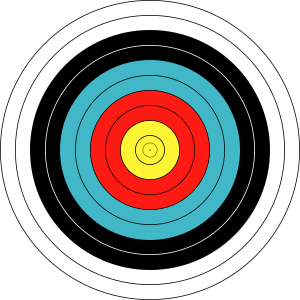Concentric objects facts for kids
In geometry, when two or more shapes share the exact same center, they are called concentric. Think of a target with rings, or a set of Russian nesting dolls. They all have the same middle point.
Many different shapes can be concentric. This includes circles, spheres (like balls), regular polygons (like squares or hexagons), and regular polyhedra (like cubes). Even shapes like parallelograms or cones can be concentric if they share a common center point.
Sometimes, shapes are coaxial instead of concentric. This means they share the same axis or line of symmetry. Imagine a long tube inside another long tube; they share the same central line. Circles, spheres, and cylinders can be coaxial.
Concentric shapes are often part of a bigger group called whorled patterns. This group also includes spirals, which are curves that start at a point and move further away as they spin around it.
Contents
What are Concentric Shapes?
Concentric Circles and Spheres
When you draw two circles on a flat surface, if they have the same center point, they are concentric. However, they must have different sizes (radii) to be considered two separate circles.
In 3D space, it's a bit different. Two spheres can be concentric if they share the same center. Think about the Earth. All the lines of longitude (like the lines that go from the North Pole to the South Pole) are circles. They are all concentric with each other and with the Earth itself. Also, any two great circles on a sphere (like the Equator) are concentric with each other and with the sphere.
Concentric Regular Shapes
Many regular shapes are naturally concentric. For example, a regular polygon (like a square or a hexagon with all sides and angles equal) has a special circle that touches all its corners (called the circumcircle) and another circle that touches the middle of all its sides (called the incircle). Both of these circles, and the polygon itself, are concentric.
The same idea applies to 3D regular shapes called regular polyhedra. They have spheres that fit inside them, touch their faces, and surround their corners, and all these spheres are concentric with the polyhedron.
Annulus and Spherical Shell
The space between two concentric circles is called an annulus. It looks like a flat ring or a washer.
Similarly, the space between two concentric spheres is called a spherical shell. Imagine a hollow ball with a smaller hollow ball inside it; the space between them is a spherical shell.
Where Do We See Concentric Shapes?
Concentric shapes appear in many places around us, both in nature and in things we build.
Nature's Concentric Patterns
When you drop a small object into still water, the ripples that spread out form a perfect example of expanding concentric circles. Each ripple shares the same center point where the object hit the water.
Tree rings are another great natural example. Each year, a tree grows a new layer, forming a new ring around the previous ones, all sharing the same center.
Concentric Shapes in Technology and Design
Targets used in target archery or other sports are designed with evenly spaced concentric circles. The goal is to hit the very center, or "bullseye."
Coaxial cables are a type of electrical wire. They are designed with a central wire surrounded by layers of insulation and another wire, all forming concentric cylindrical shells. This design helps protect the signal inside.
In the past, scientists like Johannes Kepler used the idea of concentric shapes to understand the universe. His book Mysterium Cosmographicum imagined the planets moving on spheres that were nested inside each other, like a giant set of concentric spheres and regular shapes.
Concentric circles are also used in diopter sights, which are special aiming tools found on target rifles. These sights often have a small hole near the shooter's eye and a front sight that looks like a circle inside another circle. When these circles line up perfectly, you know you're aiming at the center of your target.
Images for kids
-
Histology of a Pacinian corpuscle, in a typical expanding circular pattern.
-
Tree rings, as can be used for tree-ring dating
See also
 In Spanish: Concéntrico para niños
In Spanish: Concéntrico para niños
- Circular symmetry
- Spiral









